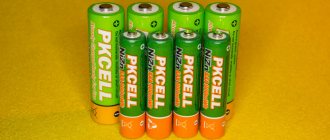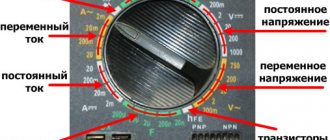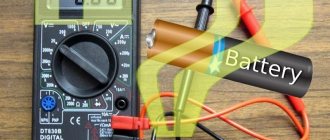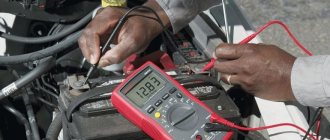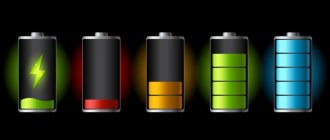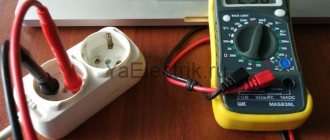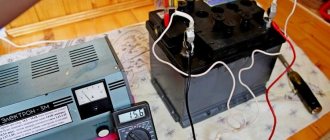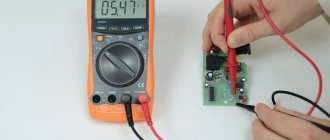Multimeter dt830b instructions for use
A multimeter is one of the inexpensive measuring instruments that is used by both professionals and amateurs who repair home wiring and electrical appliances.
Without it, any electrician feels like he has no hands. Previously, three different instruments were required to measure voltage, current, and resistance. Now all this can be measured using one universal device. Using a digital multimeter is very easy. The main two rules to remember:
- ⚡where to properly connect measuring probes
- ⚡in what position should the switch be set to measure different quantities?
Multimeter appearance and connectors
On the front of the tester, all the inscriptions are made in English, and even using abbreviations.
What do these inscriptions mean:
- OFF - the device is turned off (to prevent the device batteries from running out, set the switch to this position after measurements)
- ACV - measurement of variable U
- DCV - constant U measurement
- DCA - DC current measurement
- Ω - resistance measurement
- hFE - measurement of transistor characteristics
- diode icon - continuity test or diode test
Switching modes occurs using the central rotary switch. When you first start using your digital multimeter, it is recommended that you immediately mark the pointer mark on the switch with contrasting paint. For example like this:
Most device failures are due to the incorrect choice of switch position.
Power is supplied from a Krona battery. By the way, by looking at the connector for connecting the crown, you can indirectly judge whether the tester was assembled in a factory or somewhere in Chinese “cooperatives”. With high-quality assembly, connection occurs through special connectors designed for the crown. Lesser quality options use regular springs.
The multimeter has several connectors for connecting probes and only two probes. Therefore, it is important to correctly connect the probes to measure certain quantities, otherwise you can easily burn the device.
The probes are usually of different colors - red and black. The black probe is connected to the connector labeled COM (translated as “common”). Red probe into the other two connectors. The 10ADC connector is used when it is necessary to measure current from 200mA to 10A. The VΩmA connector is used for all other measurements - voltage, current up to 200mA, resistance, continuity.
The main criticism is caused by the factory probes that come with the device. Almost every second owner of a multimeter recommends replacing them with better ones. However, their cost can be comparable to the cost of the tester itself. As a last resort, they can be improved by strengthening the bends of the wires and insulating the tips of the probes.
If you want high-quality silicone probes with a bunch of tips, then you can order them with free shipping on AliExpress here.
Previously, pointer testers were also widely used. Some electricians even prefer them, considering them more reliable. However, due to the large error of the measurement scale, it is less convenient for ordinary consumers to use them. In addition, when working with a dial multimeter, it is imperative to guess the polarity of the contacts. For digital ones, if they are connected to the poles incorrectly, the readings will simply be displayed with a minus sign. This is normal operation and will not damage the multimeter.
What is a multimeter
A multimeter is an electrical measuring device that allows you to measure several parameters. Their minimum set:
- voltage;
- current strength and electrical resistance of the circuit section;
That is, this device contains several devices in one housing. Its name comes from the English multimeter, which can literally be translated as “multiple meter”. Previously, we called this combined device a tester or an avometer. The last name, an abbreviation for the word ampere-volt-ohmmeter, in my opinion, best reflects the essence of the device. So, this device usually combines a voltmeter, an ammeter and an ohmmeter. The letters DT in the name of the multimeter are an abbreviation for Digital Tester, which means digital tester. This means that a multimeter whose name begins with DT will be equipped with a digital display. The principle of working with all digital testers is the same. So if you master, for example, DT 832, you will know how to use a multimeter with any designation starting with DT. Below we will look at how to use a multimeter.
Application of the device
Checking the electrical equipment of a car is impossible without knowing how to use a multimeter. To do this, we will consider the example of an affordable multimeter, DT 832, which is similar in operation to its Chinese counterparts. It has measurement accuracy sufficient for repairing the electrical equipment of a car. And its retail price usually does not exceed 100 rubles. It has 3 sockets for connecting probes:
- lower – general;
- the top one is for measuring current strength;
- average – for measuring voltage and resistance.
To measure any of the above parameters, you need to connect two terminals with probes to the device. One to the common socket, the other to the socket for measuring the corresponding value. After this, use the operating mode switch to select the desired mode and check the parameter value. Equip the common wire probe with a clamp. This simple operation is simply put on the crocodile probe; if it does not hold well, squeeze the part that is being put on with pliers so that it sits tighter.
Here's what you need to do to call and find out if the wires are shorting to ground on the car. Connect the wires with probes to the lower and middle sockets. Using the switch for the type of operation, select the resistance measurement mode of no more than 200 Ohms, designated Ω 200.
De-energize the circuit that needs to be ringed and disconnect it from the consumers (if these are light bulbs, then you can simply remove them from the sockets). Make sure that one probe is in contact with the ground of the car, and the other in turn with the conductors that need to be checked. Solder a needle to one probe and pierce the wire insulation with it. If the device shows resistance from zero to several ohms, then the wire has contact with ground. In the same mode, you can check the presence or absence of a wire break. To do this, you need to attach probes to its ends. In this case, if there is no break, the indicator should show 0; a reading of several tens of ohms will indicate the presence of a break or poor contact in the connector on this section of the wiring. If there is a break, the readings of the device will be the same as with open probes. To clarify what the device should show, if the section of the circuit being examined is intact, before testing, close the probes and look at the indicator.
If you use a multimeter in ohmmeter mode, in order to test the car wiring, you do not need to observe the polarity of connecting the probes.
Basic Multimeter Operations
Voltage measurement
How to use a digital multimeter to measure voltage? To do this, set the switch on the multimeter to the appropriate position. If this is the voltage in the outlet at home (alternating voltage), then flip the switch to the ACV position. Insert the probes into the COM and VΩmA connectors.
First of all, check that the connectors are connected correctly. If one of them is mistakenly installed in contact 10ADC, a short circuit will occur when measuring voltage.
Start measuring from the maximum value on the device - 750V. The polarity of the probes does not play any role at all. It is not necessary to touch the zero with a black probe, and the phase with a red one. If a much lower value is displayed on the screen, and the number “0” appears in front of it, this means that for a more accurate measurement, you can switch to another mode, with a smaller voltage level scale that your multimeter allows you to measure.
When measuring DC voltage (for example, electrical wiring in a car), switch to DCV mode.
And you also start measuring from the largest scale, gradually lowering the measurement levels. To measure voltage, you need to connect the probes in parallel to the circuit being measured, while using your fingers to hold only the insulated part of the probe so as not to get under voltage yourself. If the display shows a voltage value with a minus sign, this means that you have reversed the polarity.
ATTENTION: when measuring voltage, be sure to check that the multimeter scale is set correctly. If you start measuring voltage with the DCA switch in the on position, i.e., measuring current, you can easily create a short circuit right in your own hands!
Some experienced electricians recommend holding both probes in one hand when measuring the voltage in an outlet. If the probes are poorly insulated and breakdown, this will allow you to protect yourself to some extent from electric shock.
The multimeter operates on a battery (a 9-volt crown is used). If the battery starts to run low, the multimeter starts to lie shamelessly. In the outlet, instead of 220V, it may seem like 300 or 100 Volts. Therefore, if the device readings begin to surprise you, first check the power supply. An indirect sign of battery discharge can be chaotic changes in the readings on the display, even when the probes are not connected to the object being measured.
Current measurement
The device can only measure direct current. The switch must be in the – DCA position.
Be careful! When measuring current, if you do not know approximately what limits the current will be, it is better to start measuring by inserting the probe into the 10ADC connector, otherwise measuring a current of more than 200mA at the VΩmA connector can easily blow the internal fuse.
Here, probes, unlike voltage measurements, must be connected in series with the object being measured. That is, you will have to break the circuit and then connect the probes into the resulting gap. This can be done in any convenient place (at the beginning, middle, end of the chain).
"Dialing" of wires
The wire testing mode is very useful for finding faults in an electrical circuit. Some devices have an audible indication that rings if the wire is intact. Our device is devoid of such “know-how” and the “diagnosis” here is displayed on the device screen by a change in indicators. In the normal state (shown in the picture on the left), the display simply shows the number 1, and when you touch a working wire (shown in the picture on the right), the numerical value will change. If the conductor is faulty, then the unit will remain on the display. As a wire, we took a working probe from Ts 4342.
The device coped with the “dialing” mode with a bang, and it ranks second after alternating voltage in terms of frequency of measurements at home.
Device information
The DT830B model is a multifunctional measuring instrument - a multimeter, which is widely used among electricians. Using this universal tool, you can determine the required parameters and electrical characteristics in the shortest possible time.
The DT multimeter is not fully classified as professional equipment and is used mainly in domestic conditions. However, the DT830B is equipped with a wide measurement range, test leads, and self-diagnosis capabilities. Therefore, the device is often used by professional electrical engineers, providing accurate measurement results. The multimeter is powered by 9-volt KRONA batteries. In general, the model is a budget option and is sold on the market at a price of up to 400 rubles.
The main difference between the DT830B digital device and analog instruments is the ability to measure many parameters, and all obtained data is presented in digital format. All elements of the circuit are placed in a small case, on the front of which the main switch is installed in the center. It is the main control element and covers approximately 20 positions.
There are icons around the circle indicating the corresponding operating modes. All obtained measurement data is displayed on a digital liquid crystal display.
Voltage measurements
The device has high-voltage voltage measurement ranges, but they are not useful for repairing car electrical equipment. And high-voltage wires are checked only for the absence of internal breaks with an ohmmeter. The remaining high-voltage elements of the car's electrical equipment are also not checked with a voltmeter. Of these, using DT 832 you can only check the resistor in the ignition distributor slider, but it should also be checked in ohmmeter mode.
To measure voltage, connect the probes to the lower and middle sockets on the front side of the device. Using the switch located there, select the mode for measuring direct voltage up to 20 V (V─ 20). Ensure that the probe of the common wire DT 832 is in contact with the ground of the car, and the other probe is in contact with the section of the wiring where measurements need to be taken. Read readings from the display.
High-voltage ranges for measuring alternating voltage will be useful to you in order to test the wiring in the apartment.
Specifications
Despite its wide functionality, the DT multimeter still lags behind professional instruments, losing to them in measurement accuracy and service life. However, the high sensitivity of the multimeter provides good measurement results, and in terms of basic indicators it is only slightly behind more expensive devices.
The DT830B multimeter is designed for a constant current of 10A, the maximum constant voltage is 1 kV. The AC voltage is in the range of 200-750 V. The liquid crystal display has a resolution of 3.5, which is a good indicator. The maximum resistance limit that can be measured is 200 kOhm. The device operates normally at temperatures of 0-40 degrees.
The dimensions of the multimeter are 126x70x28 mm. The device itself is very light and weighs only 137 grams. Compared to professional models, the number of functions is somewhat limited. However, if we take other household testers for comparison, the DT830B digital multimeter is noticeably superior to them, thanks to emergency indicators, an extended measuring scale, a diode tester and other additional options.
conclusions
The compact multimeter DT-830B is suitable for home use when you need to check the serviceability of wires, batteries, and measure direct current and voltage. It is better to double check the AC voltage. You should not use a multimeter as a professional device - for work and pranks it is better to buy a specialized device.
Advantages:
- Compact.
- Inexpensive.
- Accurate measurement of DC current and DC voltage.
- Accurate “dialing”.
Flaws:
- No fuse.
- Questionable AC voltage readings.
Operating modes
The desired operating mode is set by the switch by placing its handle opposite the corresponding sector:
- DCV. Additionally divided into five ranges. This sector is intended for measuring DC voltage in the range 0-500V. Maximum voltage occurs infrequently, for example, during TV repair. When the switch is set to 500V, an HV warning icon will appear in the upper left corner of the display to indicate the maximum level and the need for attention and caution. If the voltage value is not known in advance, switching is performed from the maximum position with a gradual transition to lower values. Failure to comply with this condition may lead to inaccurate readings or failure of the device.
- ACV. Designed for measuring alternating voltage. The sector is divided into two parts - 200 and 500V. When using the 220-380V range you need to be extremely careful. The procedure is the same as in the previous constant voltage sector.
- DCA. This sector performs the function of a milliammeter and is intended for measuring small direct currents. It is not recommended to use this sector unless necessary, and caution should be used when measuring large currents. In this case, you need to ring the chain for no longer than a few seconds.
- hFE. The sector performs continuity measurements of transistors and checks for breakdown or breakage. Elements are tested regardless of their conductivity. The legs of the transistors must be placed in the appropriate sockets, as indicated on the special socket.
- DIODE sector. When the diode is working properly, the voltage drop in the forward direction is shown in the range of 400-700 mV. For the reverse direction, infinity is used. If the diode is faulty, then a value close to zero means a breakdown, and one close to infinity means a break.
- OM sector. Used for resistance measurements. The measurement range is in the range of 200-2000000 Ohms. You should take into account the errors of the Chinese multimeter and its too high sensitivity when making accurate measurements. It is imperative to take into account the resistance that occurs when the probes are connected to each other. This is especially true when measuring resistances that are too small.
AC voltage
Encouraged by the previous readings, we moved on to testing AC voltage - what we check most often at home (especially if we live in rural areas). But here it turned out that not everything was as rosy as with constant tension. This is what we got when checking our electrical network:
Ts 4342 shows us 235 V, and DT-830B - 223 V, a difference of as much as 12 V. However, here the manufacturer protected itself and wrote in the instructions that the error when measuring alternating voltage is + - (1.2% + 8), therefore One should not be surprised at the inaccuracy. But this somehow doesn’t make us happy, because an error of 10 - 12 V can play a cruel joke on us. For example, we measure the voltage in the network, and the device shows 190 V. We call the regional power company and call a team to fix our “trouble”. They come, take measurements and it turns out that we have 202 V in our network, which is within the permissible limits according to GOST (a deviation of 10% from 220 V is allowed).
Measurements of basic parameters
The operation of the DT-830B multimeter is best considered using the example of measuring parameters that are most often encountered in everyday life. You can start mastering the device by measuring the voltage in a 220V network.
First of all, the expected measurement limit is set. The value "200" is not suitable, so you will have to use "750". The probes are installed in the required connectors, after which all that remains is to touch the two contacts available in the socket. The result will be displayed on the screen.
If the DT830B multimeter measures DC voltage, a minus sign may appear on the display. It does not always appear, since it depends on the potential of the probe with the black wire included in the COM connector. A minus sign will be displayed when the black wire has a positive potential, indicating reverse polarity.
Quite often it is necessary to find out the identity of the wire, that is, determine the phase and zero. In this case, one probe touches any grounded surfaces - ground wire, batteries, pipes, etc. The other probe alternately comes into contact with the conductors of the cable whose phase needs to be determined. In case of contact with a phase wire, a result in the range from 220 to 240V will appear on the screen.
If there are no metal grounding surfaces, another method is used for testing. You need to take one probe in your hand and touch the cable cores with the other one in turn. In this case, the multimeter will produce values of 60-240V, which also indicates the presence of a phase. The difference in readings depends on the shoes and the surface on which the examiner stands.
There is no need to be afraid of electric shock, since the DT device has a high intrinsic resistance. The most important thing is not to touch the open parts of the probe involved in the phase search. When performing such a check, you should be extremely careful and careful.
Everyone knows that electric current flows in a closed circuit. Therefore, in order to measure the current, one of the wires of this circuit must be open. After this, with the help of probes, a single circuit is formed. When attempting to measure voltage in current measurement mode, a short circuit will occur and the device will fail. The tester itself has zero internal resistance.
Before making measurements, the type of current must be correctly determined, which may be direct or alternating. If you make the wrong choice, nothing bad will happen, the device will just not show anything.
It is very important to remember that when installing probes into an electrical circuit, the voltage must be turned off. You should study the markings of the probes for the maximum current holding time. Typically, the measurement lasts no more than 10 seconds, after which the wire may begin to heat up and the insulation will melt.
Equipment
The box contained the multimeter itself, two measurement probes and instructions in Russian. The instructions, although not long, are quite detailed - they describe how to use the device, and its technical parameters with measurement errors. By the way, if you lose the instructions, everything is also described in detail on the back of the box.
I was pleasantly surprised by the presence of a Krona battery inside the device (although we bought the battery separately in advance). Please note that the DT-830B multimeter is supplied by different companies, such as Resanta, Ermak, S-Line and others, but the device itself is in all cases manufactured in China. So, from theory to practice, let's check it for measurement accuracy.
